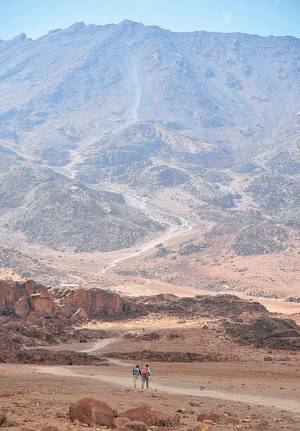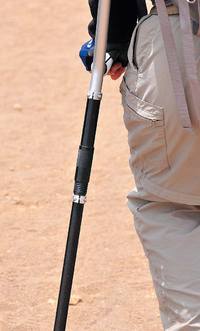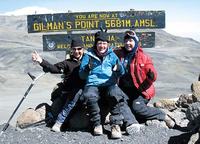Sarah Doherty Reaches for the Sky

It was midnight on January 11, 2009, and in the surreal glow of the full moon, Sarah Doherty, her twin sister Susan Gabriel, her friend Ellen Clemence and I, Sarah’s partner, left Kibo Camp, which sits at an elevation of 15,600 feet, in an attempt to summit Mount Kilimanjaro, Africa’s highest peak.
At 19,340 feet, Kilimanjaro, in northeastern Tanzania, is the world’s highest free-standing volcano. The terrain varies from loose and dusty to snowy and icy. The temperature changes are dramatic, and summit conditions are harsh: temperatures in the range of -20C, hurricane force winds, and oxygen levels less than half that at sea level.
As if this were not challenging enough, Sarah was climbing the mountain with one leg. At age 13, she was sideswiped by a drunk driver while riding her bicycle. She lost her leg, but not her will to live a full and active life.
Sarah is certainly no stranger to climbing. Twenty-five years ago, she climbed most of the higher peaks in the American Northwest, culminating in an incredible summit of Mount McKinley. She was the first and (so far) only person on crutches to do so. For those climbs, she developed specialized crutches with ice tips and snow baskets, realizing that her desire to experience the incredible outdoors was hampered not by a lack of will, but a lack of equipment.

A 25-year hiatus for motherhood and a career in occupational therapy has not lessened Sarah’s will to experience life to its fullest extent, nor her thirst for adventure. She decided to return to mountain climbing, and this time, she would tackle Kilimanjaro.
We began our expedition on January 7. After four days of walking “pole pole” (Swahili for “slowly slowly”) through three ecological zones – rainforest, moorland and alpine – we were finally setting out towards the ice fields of the summit zone. Susan, Ellen and I were armed with walking poles, and Sarah used SideStix, a shock-absorbent forearm crutch that she and I designed and planned to test on the mountain.
We set off like an exotic caterpillar, four climbers and four guides, gliding into the night. My only real recollection of the next hour and a half was of planting one foot in front of the other and “pressure breathing” – a peculiar double intake somewhat reminiscent of imbibing illicit substances (or so I’ve heard!). None of us had headaches or nausea (common at this altitude). Breathing was our only focus.

An indeterminate amount of time later (which, it turned out, was 90 minutes, one and a half miles, and 1,000 vertical feet – time and distance had a strange, elastic quality that night), I heard a curse ahead of me. Sarah had felt the cuff of her left crutch slip and assumed that it needed tightening. I turned on my head lamp, and in its harsh glow, we realized the full enormity of the situation. The crutch had snapped at the handle/forearm bend.
Sarah, with tears running down her face, saw her hopes dashed. Susan and Ellen comforted her while I continued to kneel, spinning possibilities through my mind. Giving up wasn’t an option, so we hatched a plan. Susan and Ellen would continue with their guides, Sarah would remain there with Sosta (head guide) and Octavian (junior guide), and I’d head back to camp to try to repair the crutch.
We parted company, numb from this unexpected incident. It seemed that two years of planning might all be for nothing. I indicated to Octavian (who, unfortunately, spoke as little English as I did Swahili) that I wanted to hurry, so throwing altitude-sickness cautions to the wind, we ran down the mountain.
We arrived at the camp at around 2 a.m., and while I considered repair options, I sent Octavian in search of a hammer, which I described by pantomime. He came back, smiling (as he always was), with a rock.
So, with a rock as a hammer, a padlock for an anvil, and my trusty pocket knife as a saw and chisel, I knelt on the concrete floor of the bunk room for two hours, fashioning a repair that I hoped would enable Sarah to at least walk off the mountain under her own steam.
My “safety check” comprised walking two lengths of the bunkhouse with one leg and the SideStix and declaring success (cue big smile from Octavian). I threw on my coats and we left.
We charged up the mountain. After about 30 minutes, we reached the rocks (at 16,500 feet) where we had left Sarah and Sosta, but there was no one there! I was confused, because unless they had taken a different route down, there was no way we could have missed them. I had a whistle with me, and I blew a long single blast and called Sarah’s name. No response. I tried again. This time, I heard what I thought was a faint call from up the mountain.

So, onwards and upwards…until, a while later, we came across a friend we had made on the trail, coming down with a guide. He had an awful flu before beginning the climb, and his overtaxed lungs had called it quits just before Gilman’s Point. He gave me some astounding news – he had passed Sarah, hopping up the mountain with the assistance of Sosta, and they were about an hour ahead!
With my eyes full of tears of love, admiration and awe at her determination, we carried on for 30 more minutes. Then we heard Sosta’s voice calling to us.
It was 5 a.m., and Sarah had hopped – using Sosta’s right arm as a forearm crutch – for two and a half hours, covering one and a half miles and gaining 1,000 vertical feet.
It transpired that Sarah had become too cold to remain stationary, and persuaded Sosta to help her climb higher. She wanted, if nothing else, to see the dawn rising from Hans Meyer’s Cave, halfway up the volcanic cone. In fact, they had already passed the cave, engrossed in counting steps to the next resting break.
Sosta came down from the small bluff where he and Sarah were sitting and gave me a big hug. I felt the huge strength that this small man had inside. I thanked him for being there for Sarah – and all of us.
With tears of joy all around, I explained how I’d fixed the SideStix, what its potential limitations were and how the safe course of action would be to descend. But Sarah wouldn’t hear it. She felt strong and determined, and she wanted to go on.

So, with the sky lightening over the jagged peak of Mawenzi, we inched upwards. At 6:30 a.m., the fiery orb of the rising sun climbed through the pink and purple clouds next to Mawenzi, and still we trudged, step by step, through the now-thawed scree (small, loose rocks). Like walking on sand dunes, each step forward included a half-slide backwards.
Sarah fought for breath, “pressure breathing” each lungful, so we gradually decreased the step count between breaks – 25 to 16, then to 10. Meanwhile, I fought with sleepiness. I just wanted to curl up and nap – just for a few minutes! But Sosta was ferocious in his insistence that we stay awake – people who sleep could die!
Sarah finally allowed Octavian to take her backpack, which gave her much-needed respite. Goal by goal, target by target, we climbed closer to Gilman’s Point at the edge of the crater.
By 8 a.m., we had started scrambling over boulders. The change of surface was greatly welcomed, if for no other reason than to break the monotony of the previous three hours. Of course, the boulders, which were covered with a light dusting of sand and pebbles, posed their own particular challenges; however, the studded SideStix tips kept good purchase.
In the last hour before summiting Gilman’s Point, numerous people passed us on their way down. The encouragement they gave us was invaluable and uplifting, and it certainly played a part in giving us the energy we needed to climb into the small pocket of rocks that makes up the crow’s nest of Gilman’s Point. It was 9:30 a.m., and we were 18,711 feet above sea level. Against all odds, Sarah had climbed, hopped and scrambled up the hardest part of Mount Kilimanjaro.
To read Kerith Perreur-Lloyd’s blog entries from his and Sarah Doherty’s Kilimanjaro climb, visit www.sidestix.blogspot.com.














